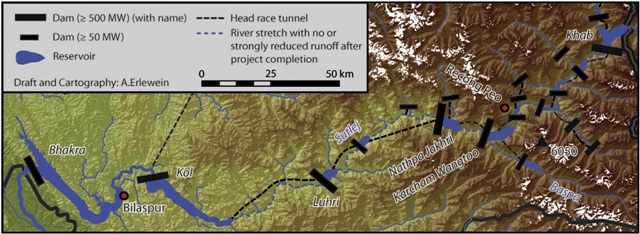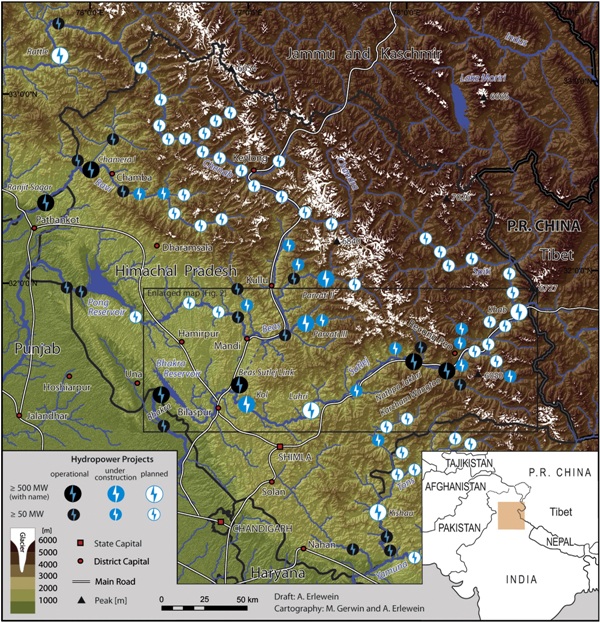Shimla: Faulting the myopic Indian practice of project level environmental impact assessment (EIA) for extensive hydropower development in river basins of Himachal Pradesh, a University of Heidelberg, Germany study warns that it had failed to address larger ecological effects like disappearing of rivers over long stretches.
Research geographer Alexander Erlewein in the paper ‘Disappearing rivers – The limits of environmental assessment for hydropower in India’ to be published in the November 2013 issue of international journal Environmental Impact Assessment Review but already published online observes that mountain rivers, converted into cascades of power projects, are altering ecological conditions and leaving little space for original habitats.
There being a high demand for export of energy, the Himachal government has made this lucrative option ‘the principal and perennial source of revenue for the state’ in its 2005 hydropower policy.
The paper focuses on systemic limitations of the current system for environmental assessment.
Though environmental laws necessitate drawing up EIAs to predict likely environmental and social impacts of project implementation, effectiveness of the system to reduce and mitigate environmental impacts has been questioned by many studies.
Several shortcomings in EIA system that the paper points out were inadequate screening and scoping, poor quality EIA reports, failure to consider alternatives, inadequate public participation, insufficient implementation of mitigation and monitoring measures and weak impact of impact assessments on decision making, comments the study.

“Sutlej enters India at 3000 m altitude and Bhakra is at about 500 M, in between only for few short stretches the river will be preserved in its current form. Ravi out of 70 Km will only flow for 3 KM in its original bed,” observes Erlewein.
Though Himachal has enacted a unique legislation of 15 % minimum flow in lean season, but it was not being followed by project owners, something research revealed during field visits made to various project sites.
Fragmentation of rivers into stretches has started to severely damage, if not destroy the habitat of all animal and plant species that depend upon it for their migration and dissemination. Farmers in Kinnaur reported hundreds of natural springs having run dry since widespread construction of hydropower projects in the region began.
Though dumping of muck in rivers is illegal but visits to project sites showed that it was being violated with impunity. The paper has expressed much concern over dried up river beds causing decrease in air moisture that may lead to more arid microclimatic conditions in upper Sutlej, Chandra and Spiti rivers.
The paper also records that the Himachal Pradesh High Courts recommendation that “the state government should carry out basin wide EIAs for all river basins and until these are finalized no more hydel projects should be allotted” had been brushed aside by the concerned authorities.
With the dominant view of the states power policy being “to develop the total hydropower potential” the paper quotes an environment organisation describing it as a “guideline for the privatization of rivers for power generation.”

Lack of coordination in dam building among developers was also wrecking environmental havoc as most preferred to set up own facilities for power evacuation, production of construction materials, road access etc. At places up to 5 transmission lines running parallel to each other were seen.
Small hydro project (<25MW) which have been kept out of the EIA legislation have to prepare detailed project reports to describe local impacts but “ villagers in project affected villages in Kullu and Kinnaur stated that from social point of view small hydro projects on tributaries can be more harmful than large dams on rivers.
This is because of central role of small streams and tributaries play for the water supply of villages. The diversion of such streams severely threatens local livelihoods and locals. In contrast, main rivers in the upper reaches are hardly used for water supply.
Construction and operation of small hydropower projects can lead to other significant impacts such as deforestation, soil erosion, biodiversity loss and disturbances of groundwater regimes.
Though at only one place the Himachal Pradesh hydropower policy does recognize that, ‘the state government may allow the natural flow of some of the portions of the rivers in the state in order to exhibit the existence of such river in its pristine beauty before it disappears through the maze of tunnels and thus obliterate its very existence” but at the decision level it is overlooked in favour of developing all available hydropower potential
After recording inadequacy of EIA regulations in addressing significant environmental aspects of hydropower development, the paper makes case for undertaking ‘ Strategic Environmental Assessement, that is legally necessary in China and a number of Asian countries but India only has limited experience in it.
The paper cites the case of Mekong River which clearly analyses “what will be lost, what will be gained and who will lose and as well who will gain”
The paper argues that SEA has the potential to address the urgent problem of cumulative impacts and would allow for examination of strategic alternatives, something that is almost missing in Indian hydropower planning so far.
Himalaya does not only serve as the water tower of South Asia but increasingly also functions as the power tower that generates electricity, the study infers.
SEA could play a major role in closing knowledge gaps regarding cumulative and basin effects and making the due consideration of environmental aspects an integral part of decision making.
As Editor, Ravinder Makhaik leads a team of media professionals at Hill Post.
Spanning a career of over two decades in mass communication, as a Documentary Filmmaker, TV journalist, Print Media journalist and with Online & Social Media, he brings with him a vast experience. He lives in Shimla.


